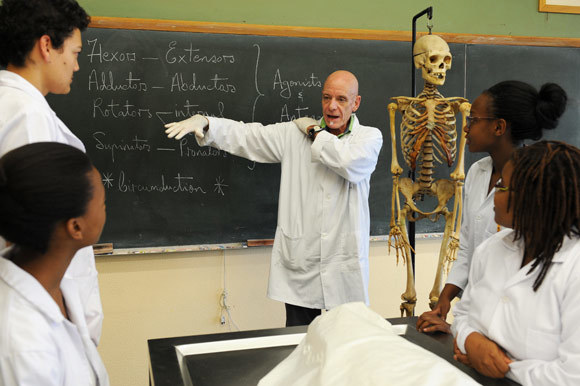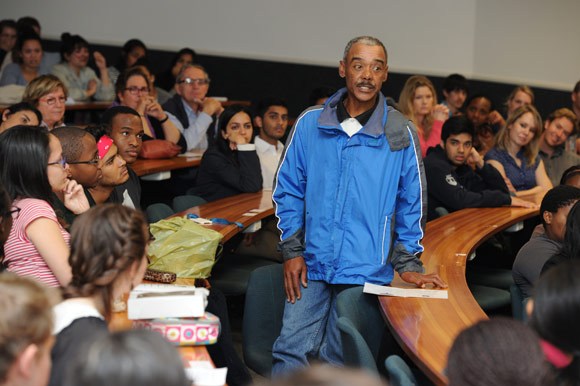Anatomy of a teacher
01 December 2014 | Story Helen Swingler. Photos Michael Hammond.
'Teachers on the table', bodies donated to UCT's anatomy laboratory for dissection by second-year medical students, are a vital part of medical education, even when the donor is a centenarian - a trend that's increasing, says Professor Graham Louw.
Louw was speaking at the cadaver dedication ceremony in the Student Learning Centre. Each year students honour the body donors and thank their families, often in song and verse. The observance provides what health sciences dean Professor Wim de Villiers called "a time of reflection and celebration".
Body donors - 'silent mentors' to students as they discover the intricacies of human anatomy - are a gift to the university and are treated with care and dignity, Louw told their families.
"Respect and ethics are vital in training to be a doctor," added Professor Malcolm Collins, head of the Department of Human Biology.
For many students it's a rite of passage, said De Villiers; their first confrontation with death.
One family spoke fondly of their 100-year-old aunt, a donor who'd died in fine fettle, with no hint of Alzheimer's or dread disease.
And there were more donors like her, said Louw, referring to two 101-year-old men who had arrived at the faculty's mortuary.
"There's been a change in the demographics of the bodies we receive. More and more are over 100 years old, a reflection of improving quality of health, advanced healthcare services, and better education about health care.
"Ten to 20 years ago most were aged between 70 and 80. This has shifted by 20 years; we're now getting donors in their 90s and early 100s. People are surviving illnesses that they didn't in the past. It's one of the reasons many older people donate their bodies; medical progress gave them so much."
Older bodies are also useful teachers, showing, for example, the ravages of lifelong alcohol abuse on the liver, the demise of the female reproductive system post-menopause, and the accumulative effects of HIV and TB.
Each cadaver is a mirror of a life: the appendectomy scar; the stainless steel pins in a bone; pacemakers; breast implants; prostheses; and synthetic lenses.
"Every body has a story to tell," said Louw.
Males are now also better represented among donors, he went on, thanks to better medical intervention and treatment for the testosterone- and adrenaline-driving behaviour that causes heart attacks and strokes - and car accidents.
Today's donors are also taller than their counterparts in the past. Stainless steel tables recently replaced the original marble dissection tables, which dated back over 100 years. These are easier to clean, but they also accommodate cadavers that are now 10 to 20cm taller than they were a century ago.
Unfortunately, very few teenage or younger bodies are donated, and this gap is noticeable in the curriculum. "You can't take adult anatomy and shrink it; children are very different," said Louw.
Somerset Hospital donates newborns - those who are stillborn or die of natural causes, and whose mothers abandon the bodies - for neonatal studies. Half of the adult bodies donated are unclaimed: paupers, prisoners, and the homeless.

Louw paid tribute to them too. "We remember the people who came to us without an identity, without a name. They were marginalised by society, and at least today we can express gratitude that we were able to use their bodies and give them a dignified passing."
Some bodies are embalmed for the dissection table; others are frozen for surgical teaching; while some are used to practise new techniques. Others still are plastinated (the fat and water are replaced by silicon) and are used for demonstration.
Paradoxically, donors help improve quality of life.
"The donors make it possible for future doctors to understand anatomy; not just to learn it from a book, but to actually see the three-dimensional structure of the body - and this, even with all our modern technology, is critically important," said Collins. After the ceremony, a son whose mother had donated her body said to the students: "Thank you. You guys are the future and my mom would have been so proud of you."
Another had been the partner of a donor for 25 years.
"Steve and myself were models for art students all over the country, and at the end we always thought we would educate people; so we thought we'd donate our bodies to science."
In closing, De Villiers said that as part of their training, students were being hardwired to care for patients in a community, "part of a transformative experience".
Body donors, he added, were examples of a 'good death'; selfless, and with a greater cause in mind.
 This work is licensed under a Creative Commons Attribution-NoDerivatives 4.0 International License.
This work is licensed under a Creative Commons Attribution-NoDerivatives 4.0 International License.
Please view the republishing articles page for more information.










